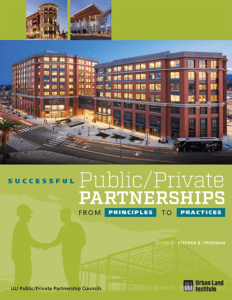The challenges and opportunities associated with creating effective public/private partnerships in the current economic environment are explored in Successful Public/Private Partnerships: From Principles to Practice,a new ULI publication.
The report, overseen by the Institute’s Public/Private Partnership Council and funded by the ULI Foundation, builds on ULI research published in 2005 on public/private partnerships (PPPs), which identified core principles essential for the accomplishment of joint development projects by the public and private sectors. Since then, the need for PPPs has expanded beyond mutually beneficial development to include the development and ensured maintenance of critical infrastructure, as well as the design, construction, operation, and maintenance of public facilities to achieve the goal of building healthy and resilient communities. In addition, the landscape for development is being affected by major forces of change, including demographic and population shifts, the connection between land use and transportation, a growing affordable housing shortage, climate change concerns, and new economic growth drivers.
ULI leader and Public/Private Partnership Council member Stephen B. Friedman directed the research and served as the primary editor and author of Successful Public/Private Partnerships, which also includes contributions from several other council members. “Creating productive PPPs to address pressing urban issues is more necessary today than ever before, given public sector needs and fiscal constraints,” said Friedman, president of SB Friedman Development Advisors. “Success depends on building trust between the two sectors, and often, a change in mind-sets. For the public sector, it means being a facilitator of projects providing public benefits. For the private sector, it means being a collaborator negotiating profitable projects with public benefits.”
A survey of the Institute’s Public/Private Partnership Council members conducted in conjunction with the report identified the top challenge in crafting effective PPPs to be public sector understanding of private capital criteria and return requirements. Survey participants listed real estate finance as the most necessary area of expertise needed by public sector officials; and the area of expertise most needed in the private sector was described as “how to explain the project risk profile and capital financing so the public agency can respond effectively.”
The report identifies the three most common types of PPPs:
- PPPs created to facilitate development of a community asset or community area—these partnerships have the power to develop or redevelop an area or a site, often blighted or underused, within a community.
- PPPs created to develop critical infrastructure—these are arrangements that often take the form of a long-term performance-based contract between the public and private sectors to deliver public infrastructure.
- PPPs created to monetize public assets for public benefit—these partnerships find ways to unlock the existing monetary value found in many public assets today.
It offers a toolkit of best practices for effectiveness, including tips on creating a shared vision and public purpose; assembling public and private members for the development team; laying the groundwork for successful PPPs; assessing the fiscal impacts and community benefits; structuring development partnership deals; structuring infrastructure and facility PPPs; managing risk and sharing success; and documenting and monitoring deals.
The following examples of successful projects resulting from PPPs are highlighted in the report:
- The Shops and Residences of Uptown Park Ridge in Park Ridge, Illinois, and Crossings/900 in Redwood City, California—both catalytic mixed-use developments that revived the downtown area.
- Bartlett, Illinois—cited for a significant predevelopment effort to ensure support for the creation of a town center.
- Midtown Miami—Miami’s largest PPP project, Midtown Miami involved the redevelopment of an abandoned rail yard into a vibrant mixed-use community.
- Brickell City Centre in Miami—a mixed-use project under construction as part of the downtown’s ongoing revitalization.
- McMillan Development Community Benefits Agreement (CBA) in Washington, D.C.—A CBA created to address residents’ concerns regarding a proposed mixed-use development, which resulted in the provision of several new services and amenities to benefit the surrounding communities.
Other PPP-led projects cited in the report include Silver Spring Town Center in Silver Spring, Maryland; Governor George Deukmejian Courthouse in Long Beach, California; Berkeley Repertory Theatre in Berkeley, California; and Mission Bay in San Francisco.
“Public/private partnerships are a critical vehicle for accomplishing key community development objectives with regard to real estate development and redevelopment, infrastructure and public facilities, and monetization of existing public assets for public benefit,” the report says. “These partnerships tap the expertise, tolerance for risk, and financial resources of the private sector to help achieve these goals. However, they are complex, and the public and private sectors approach such transactions with different skills, concerns, and perspectives.
“Building shared vision, knowledge, and trust is essential. Through these tools and methods (identified in the report), the public and private sector concerns can be bridged to use PPPs to the benefit of the community with appropriate profit and returns to the private sector.”
Preparation of the report was overseen by the Rose Center for Public Leadership, which encourages and supports excellence in land use decision making by local governments. A program of the National League of Cities in partnership with ULI, the Rose Center seeks to foster creative, efficient, practical, and sustainable land use policies by providing public officials with access to information, best practices, peer networks, and other resources.





